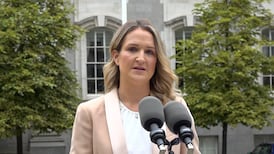Just what happened at Leinster House on Wednesday?
A crowd of around 200 people gathered for a protest timed to coincide with the reopening of the Dáil after its summer break. While this is in no way unusual, the tactics of some protesters and the erection of a mock gallows have led to widespread concern and calls for increased security in and around the parliament.
A gallows?
Yes – it was plastered with images of politicians from across the political spectrum, and a figure in a suit was hung in effigy. Gardaí are now investigating whether the setting up of the gallows could be a crime in and of itself. Protesters also jostled TDs attempting to enter Leinster House, with two – Independent TD Michael Healy-Rae and Sinn Féin’s Donnchadh O’Laoghaire – needing Garda assistance and an escort away from the area, videos show. Later, protesters blocked the car park exit at the Merrion Street gates to Leinster House, preventing politicians from leaving.
A total of 13 people were arrested at the protest. Two have appeared in court with the remainder appearing in October.
What was this all about?
Take your pick. The rally was organised on social media accounts and networks populated by Ireland’s far-right groupings, where it was dubbed Call to the Dáil. Gardaí had anticipated trouble and erected barriers and put in place an alternate plan for accessing Kildare street. Some protesters verbally abused some TDs and others working in Leinster House. No single policy or party was the target of the protest, with politicians across the political spectrum depicted on posters describing them as “globalist traitors”.
READ MORE
Protesters displayed signs on a variety of tropes that have mobilised the far right here, including Covid vaccines, migration, trans rights, sex education for children, the World Economic Forum, and support for Ukraine. They were widely criticised across the political spectrum, with critics differentiating between peaceful and critical protest and what happened on Wednesday.
Who was involved?
Typical of these events, the protest appears to have been organised on social media in a somewhat decentralised way. However, attendees included several figures from far-right politics and political groupings familiar from a spate of anti-immigration protests that have taken place across the country in the past year.
What happens next?
Leaving aside the arrests for the moment, a security review at Leinster House has been announced, and the Ceann Comhairle met senior gardaí on Thursday. He has signalled that some enhanced security measures will be considered, while gardaí are expected to examine their own strategies for policing protests around the Leinster House complex.
Part of whatever comes next will be a delicate balancing act: all parties are eager to preserve the right to protest at the national parliament, and also avoid draconian or restrictive measures that would undermine the idea that, in the Ceann Comhairle’s words, Leinster House is “the people’s house”. However, there are genuine security fears to be considered as well. The protests come amid heightened concern about politicians’ security, with a working group under former Garda commissioner Nóirín O’Sullivan examining this. The Taoiseach said on Tuesday that threats against politicians had come from people with a history of violence and convictions, and Garda drivers have been reinstated for all Cabinet ministers on the advice of commissioner Drew Harris.
Whatever happens next, it appears that this protest and associated matters reflect a clear change in political life in Ireland.















